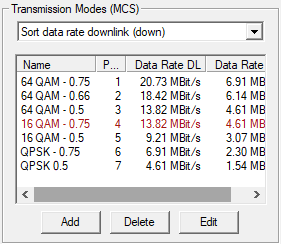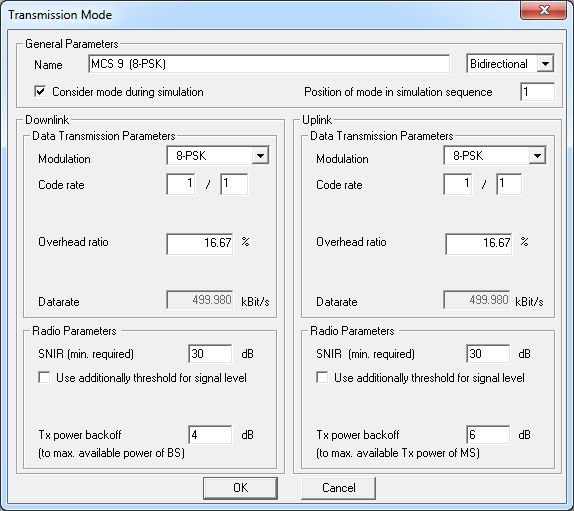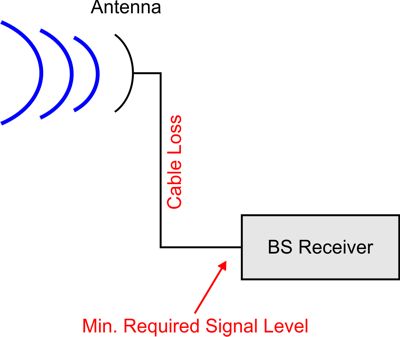Modulation and Coding (FDMA)
Modulation and Coding Schemes (MCS) for FDMA Systems
To view a list with the currently defined MCS, click and click the Air Interface tab. Further transmission modes can be defined, existing ones can be adapted during the planning process. The defined transmission modes can be sorted considering various criteria. The order of the MCS does not influence the simulations but the sequential arrangement in the tree view and on the dialogs.

Figure 1. The Transmission Modes (MCS) dialog.
To define the trasnmission parameters of a FDMA system in ProMan, double-click on an item in Figure 1. The settings can be specified for the downlink (BS to MS) and the uplink (MS to BS) direction separately.

Figure 2. The Transmission Mode dialog.
- Name
- Arbitrary name for transmission mode.
- Direction to be analyzed
- Downlink and uplink directions can be analyzed individually for each transmission mode. It is possible to analyze transmission modes for Only Downlink or for Only Uplink without the influence of the other direction.
- Consider mode during simulation
- If this option is enabled, the transmission mode is considered during network planning simulation. Transmission modes which are specified to be not considered during simulation, are displayed in red (see Figure 1).
- Position of mode in simulation sequence
- The position (priority) of the transmission modes affects the throughout results
as the transmission modes are analyzed according to their position value. The
networks are configured to maximize the throughput. For this purpose the
transmission mode with the first position should be analyzed first. If there are
some radio resources remaining, then the transmission mode with the second
position is analyzed for checking if the throughput can be further increased and
so on. So to maximize the throughput, the transmission modes should be
assigned reasonable values for the position. Without this sorting it might happen
that transmission modes with low data rates use the available radio resources and
thus the maximum throughput is not exploited.Note: It is not possible to have multiple transmission modes with the same position in simulation sequence. The individual positions of the transmission modes do not have to be consistent (gaps are possible).
- Data Transmission Parameters (for downlink and uplink)
-
- Modulation
- Modulation scheme used for data transmission.
- Code rate
- The code rate states the portion of the total amount of information that is useful (that is non redundant). If the code rate is k/n, k bits out of n totally generated bits are useful information, whereas (n-k) bits are redundant. The redundant bits are used for error detection and correction.
- Spreading Factor
- The spreading factor or processing gain, the ratio between chip rate and symbol rate of the transmission mode.
- Overhead ratio
- Ratio between gross and net data rate.
- Parallel Used Codes
- Number of codes, which are used in parallel to achieve higher
data rates. The defined factor is considered for the resulting data rate,
which is automatically computed in the corresponding field.Note: If multiple codes are used in parallel the own cell interference is increased in addition to the interference due to predefined cell load. Furthermore the required Tx power is increased. Accordingly there are limitations due to the defined maximum Tx power of the base station and the defined Eb/N0 target for the transmission mode. Both effects are considered in the network simulation. The computed results shown in the result tree under the defined transmission modes refer to the transmission of a single code, but the throughput results depend on the number of parallel codes (increasing the data rate which is multiplied with the number of possible streams).
- Data rate (read only)
- Net data rate, which is automatically computed according to the parameters specified above.
- Radio Parameters (for downlink and uplink)
-
- SNIR (min. required)
-
Minimum signal-to-noise-and-interference-ratio, which is required to use this transmission mode. Receiver locations, where the predicted SNIR is above this threshold will be assigned to this transmission mode and the maximum available data rate for the corresponding Rx locations will be set to the value specified for this MCS.

Figure 3. Antenna and Base Station Receiver scenario. - Use additionally threshold for signal level
-
Optional threshold of signal level, which is required to use this transmission mode.
Note: The specified minimum signal level for the uplink direction refers to the input of the base station receiver and not to the power received directly at the antenna. In case a cable loss is defined, the received power at the antenna is further reduced by the cable loss before it is compared to the specified minimum required signal level. - Tx Power Back off
- Power headroom which can be specified related to maximum available
transmit power of the base station (for downlink direction) or the mobile
station (for uplink direction), respectively. This headroom can be used
to reduce available transmission power and therefore crosstalk
probability for high modulation and coding schemes.Note: This back off value influences only the transmit power used for data transmission. The power assigned for pilot signals is not influenced.